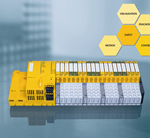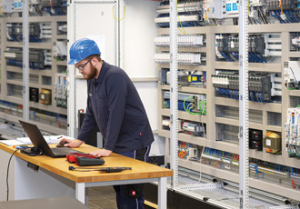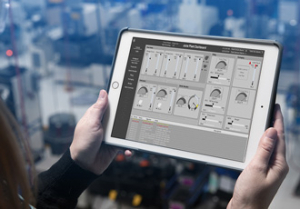Pilz PSS4000 redefines decentralised machine control
28th May 2009
Source:
Pilz Automation Safety L.P.

Pilz Automation Technology is launching the PSS4000 Automation System and PAS4000 software suite that together provide a new way to design, program and implement automation. A key feature of the concept is the integration of safety, standard and motion control, as well as visualisation and diagnostics, with all data conveyed via a SafetyNET p Ethernet-based industrial fieldbus network. In addition, the software suite enables all aspects of an automation project to be accessed via a single interface.
The Pilz PSS4000 takes decentralised machine control to a new level by virtue of the close integration of all aspects and the way in which configuration and programming of the entire decentralised control system is carried out via a single Pilz Automation Suite, the PAS4000. Material can therefore be copied and reused extremely easily both within a project and from one project to another. This feature is believed to be unique.
Today machine designers typically specify the hardware then write the control program to suit. However, any changes required either during the development or after the machine has entered service are cumbersome and costly to execute. With the PSS4000 and PAS4000, this approach is turned on its head. The programming phase can start as soon as the machine's basic functions are known, with the hardware specification following on or taking place in parallel. This saves time in the development phase and means that changes are much simpler and less costly to implement.
Another innovation in the PAS4000 suite is the programming of safety-related functions using tools that are compliant with the IEC 61131-3 standard for PLC programming languages. Pilz believes that this is another industry first. Furthermore, safety has been integrated from the outset rather than added later, which means that it is far more closely integrated with the other aspects of the system than is the case with products from other manufacturers.
The PSS4000 system suits a wide range of machine types, with the biggest benefits likely to be found in complex or modular machines. The hardware architecture also means that customers only pay for the functionality that they need.
Three classes of PSS4000 hardware device are being launched, all designed to withstand shock and vibration as well as temperatures of -40 to +70 degrees C.
• The PSSuniversal PLC is a programmable controller for safety and standard control functions. Up to 64 I/O modules can be connected for communicating with safety and standard devices. Each PSSu PLC features an integral power supply, an Ethernet switch and two Ethernet ports for programming, communicating with other devices on the SafetyNET p network and remote access via Ethernet TCP/IP. Configuration and program data is stored on an SD card so that, in the event of the hardware having to be replaced, the SD card can be transferred to the new hardware and the system made operational in the shortest possible time.
• For smaller or less complex applications, the PSSuniversal multi is effectively a functional expansion of the existing Pilz PNOZmulti modular safety controller.
• PSSuniversal I/O modules provide remote I/O connections for safety and standard devices, with two Ethernet ports, an Ethernet switch and a SafetyNET p interface.
These three types of head unit can be used in virtually any combination within a single overall system, and each head unit can be fitted with a wide variety of safety and standard I/O modules. Up to five head units can be connected using link modules, with a maximum separation between head units of 100m
The backbone of the PSS4000 system is SafetyNET p, in which safety-related data and standard control data are physically mixed but logically separated. Pilz has developed two speed classes of SafetyNET p: RTFN (real time frame network) for fieldbus class communication and for networking individual production cells with processing cycles of approximately 1ms; and RTFL (real time frame line) for real-time communication in highly dynamic applications where a guaranteed scan time of 62.5us or less is required. Both speed classes are compatible with each other and may be used separately or in combination. Users can create linear, star or tree topologies, or any hybrid of these, plus other industrial Ethernet systems or Ethernet-compatible devices can be connected to SafetyNET p.
Where non-safety wireless communications are required, Pilz offers InduraNET p (Industrial Radio Network). InduraNET p modules are available to add wireless links seamlessly to a SafetyNET p network and, therefore, a PSS4000 Automation System.
In developing the PSS4000, Pilz placed a great emphasis on creating a user-friendly and versatile suite of software tools that enable all aspects of the system (safety, standard control, motion control, etc) to be accessed from a single interface. Furthermore, the programming complies with the IEC 61131-3 standard and Pilz has provided an extensive library of standard functions.
Universal symbolic descriptions of signals, programs and devices ensure clear plant programming and provide easier navigation and a more intuitive view of the control system. A system-wide mapping table aids clarity, prevents duplication of symbolic addressing, and makes it simpler and quicker to modify the system later.
Today machine designers typically specify the hardware then write the control program to suit. However, any changes required either during the development or after the machine has entered service are cumbersome and costly to execute. With the PSS4000 and PAS4000, this approach is turned on its head. The programming phase can start as soon as the machine's basic functions are known, with the hardware specification following on or taking place in parallel. This saves time in the development phase and means that changes are much simpler and less costly to implement.
Another innovation in the PAS4000 suite is the programming of safety-related functions using tools that are compliant with the IEC 61131-3 standard for PLC programming languages. Pilz believes that this is another industry first. Furthermore, safety has been integrated from the outset rather than added later, which means that it is far more closely integrated with the other aspects of the system than is the case with products from other manufacturers.
The PSS4000 system suits a wide range of machine types, with the biggest benefits likely to be found in complex or modular machines. The hardware architecture also means that customers only pay for the functionality that they need.
Three classes of PSS4000 hardware device are being launched, all designed to withstand shock and vibration as well as temperatures of -40 to +70 degrees C.
• The PSSuniversal PLC is a programmable controller for safety and standard control functions. Up to 64 I/O modules can be connected for communicating with safety and standard devices. Each PSSu PLC features an integral power supply, an Ethernet switch and two Ethernet ports for programming, communicating with other devices on the SafetyNET p network and remote access via Ethernet TCP/IP. Configuration and program data is stored on an SD card so that, in the event of the hardware having to be replaced, the SD card can be transferred to the new hardware and the system made operational in the shortest possible time.
• For smaller or less complex applications, the PSSuniversal multi is effectively a functional expansion of the existing Pilz PNOZmulti modular safety controller.
• PSSuniversal I/O modules provide remote I/O connections for safety and standard devices, with two Ethernet ports, an Ethernet switch and a SafetyNET p interface.
These three types of head unit can be used in virtually any combination within a single overall system, and each head unit can be fitted with a wide variety of safety and standard I/O modules. Up to five head units can be connected using link modules, with a maximum separation between head units of 100m
The backbone of the PSS4000 system is SafetyNET p, in which safety-related data and standard control data are physically mixed but logically separated. Pilz has developed two speed classes of SafetyNET p: RTFN (real time frame network) for fieldbus class communication and for networking individual production cells with processing cycles of approximately 1ms; and RTFL (real time frame line) for real-time communication in highly dynamic applications where a guaranteed scan time of 62.5us or less is required. Both speed classes are compatible with each other and may be used separately or in combination. Users can create linear, star or tree topologies, or any hybrid of these, plus other industrial Ethernet systems or Ethernet-compatible devices can be connected to SafetyNET p.
Where non-safety wireless communications are required, Pilz offers InduraNET p (Industrial Radio Network). InduraNET p modules are available to add wireless links seamlessly to a SafetyNET p network and, therefore, a PSS4000 Automation System.
In developing the PSS4000, Pilz placed a great emphasis on creating a user-friendly and versatile suite of software tools that enable all aspects of the system (safety, standard control, motion control, etc) to be accessed from a single interface. Furthermore, the programming complies with the IEC 61131-3 standard and Pilz has provided an extensive library of standard functions.
Universal symbolic descriptions of signals, programs and devices ensure clear plant programming and provide easier navigation and a more intuitive view of the control system. A system-wide mapping table aids clarity, prevents duplication of symbolic addressing, and makes it simpler and quicker to modify the system later.
Similar articles
More from Pilz Automation Safety L.P.
- Advice from Pilz as the transition period for EN 954-1 is extended 17th December 2009
- Machinery safety training courses with a practical edge 24th July 2009
- Pilz PSS4000 redefines decentralised machine control 28th May 2009
- Machinery safety and the need to save money 9th March 2009




 technology at Jacobs Vehicle Systems.JPG)







Write a comment
No comments